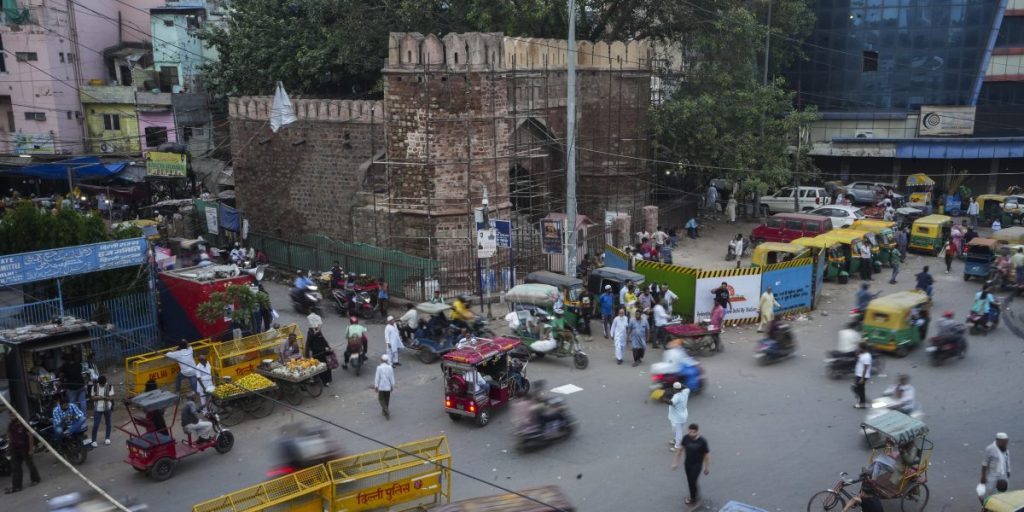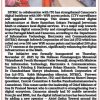Goa is abuzz with excitement as vintage bike and car owners, users, collectors and fans are decking […]

THE ECONOMICS OF THE EMERGENCY!By Arun Kumar
In the News, June 28- July 04, 2025 June 27, 2025The Emergency provided a yardstick to rulers to justify their social and political acts of regression
Fifty years ago, on June 25, 1975, the Emergency imposed by the then prime minister, Indira Gandhi.
When Indira Gandhi imposed Emergency in 1975, the nation’s existence was not jeopardised, externally or internally. An ex-post justification was given that the opposition’s movement against corruption, posed an internal threat. The trigger for the declaration was the Allahabad high court disqualifying Gandhi from holding office on account of her having committed electoral malpractice. That threatened Gandhi’s position as prime minister.
This was no threat to the system or nation, but the sentiment must have been what the Congress party president, Deb Kant Baruah had said then – “India is Indira and Indira is India”. Even as late as the early 1990s, a Congressman told this author at a dinner that there can be no India without the Congress party. It was this mindset that led to the imposition of the Emergency. A personal issue was depicted as a systemic issue.
Back then, the system did not need an Emergency to cope with India’s prevailing challenges, but long term consequences followed due the needless flipping of the system. A paradigm shift occurred just as had happened in 1947 with the Independence. It changed societal discourse.
Background to the Emergency
1971 started with the crisis in the then East Pakistan, leading to a massive influx of refugees (up to 12 million) which strained the Indian economy and society. Relations with Western powers, especially the USA, deteriorated because they did not want Pakistan, their ally, to split. In December 1971, India enabled a split in Pakistan and emergence of Bangladesh. This boosted Gandhi’s image as a strong leader. She had already won the elections securing a good majority by invoking the ‘garibi hatao’ or ‘remove poverty’ slogan. In 1967, when Gandhi first became PM, she was seen as a weak leader and was called a ‘goongi gudiya’ or ‘dumb doll’. This image slowly transformed as she turned the tables by ousting the conservatives in the Congress and announcing bank nationalisation and the abolition of privy purses. Coal mines in 1971 and textile mills in 1974 were nationalised. FERA was promulgated in 1974 to dilute foreign ownership of multinational companies and conserve foreign exchange. For a short while, wholesale wheat trade was nationalised in 1972 to check hoarding and price rise.
Clearly, Gandhi followed left of centre policies. In the PMO, P.N. Haksar was her principal advisor along with a group of people of similar persuasion.
The year 1972 saw one of the most severe droughts in India, leading to high inflation and shortages. The situation was aggravated by the Yom Kippur war of 1973 which led to a surge in crude oil prices globally and that impacted India. This led to social and political unrest in the country and the sentiment turned against the government. In course, the Nav Nirman movement started in Gujarat and turned into the JP movement. A big strike in the Railways in 1974 further aggravated the situation.
Gandhi’s big mandate of 1971 quickly dissipated. Poverty persisted due to the crisis, thereby making ‘garibi hatao’ an empty slogan and discrediting the left of center agenda. But there was no systemic crisis which needed the declaration of an Emergency.
Emergency and paradigm shift
Emergency saw the arrest of the opposition leadership – leftists, socialists and the rightist. Authoritarian rule was imposed with Gandhi’s younger son, Sanjay, taking charge along with his ginger group. Dissent was quashed and press censorship promulgated. A populist 20 point programme was launched with elements of a progressive programme like, minimum wages and land ceiling. But, overall policies were to the right of centre. Haksar and his group were marginalised and thus started the long-term rightward drift in India in social, political and economic terms.
Population control was imposed through sterilisation and this produced a reaction amongst major sections. Urban slum-dwellers were forcibly resettled in places far from their places of work. Neither minimum wages nor land ceiling could be implemented, so poverty and inequality persisted. Even though agriculture recovered from drought, price rise moderated and shortages ended, Gandhi’s popularity ebbed. She did not realise this because she was cocooned. She ordered elections in 1977 and ended the Emergency. She lost comprehensively and the Janata coalition came to power.
The Emergency saw the start of the revolving door policy. Experts from the World Bank and IMF became increasingly influential and entered the government in policy making positions. Officials in the government started to aspire to work in these agencies to earn big. This made policy makers receptive to policy prescriptions from these agencies, representing the interest of International Finance Capital. These agencies influenced intellectuals more broadly by organising seminars abroad and offering consultancies. A three month consultancy could help to buy a car and a one year stint could enable one to own a flat. India’s independence in policy making slowly eroded.
Global shifts
International Finance Capital’s interest was in marketisation and opening of the economy. So, since the Emergency, the pendulum swung from the state to the markets. State was projected as inefficient while markets were postulated to be efficient. So, market based solutions were proposed for every sector and activity. That was theoretical while in reality market failure is rampant in a modern economy and to achieve optimality, government intervention is required. This drift to the right was reinforced by global strategic changes in the mid-1970s. Soviet Union started declining and lost its ability to help the developing world. China took a 180 degree turn and went for a capitalist growth path with the ascendency of Deng Xiaoping after the death of Mao Zedong. Deng justified this shift by saying ‘how does the colour of a cat matter’. Mao’s meeting with Nixon in 1972 had opened the path to this change.
Thatcherism and Reaganism promoted marketisation from 1978, culminating in ‘endism’ in 1990. Capital has gained at the expense of labour due to its high mobility. It is able to extract concessions from a weakened state due to the global financial architecture and rise of illegality. The state’s capacity is further reduced by BEPS, ‘race to the bottom’ and FRBM. The result is the rule of ‘1% over 99%’, clearly visible during the global financial crisis in 2008.
So, since the mid-1970s there is a rightward drift in political, social and economic terms not only in India but globally. The Left in India has lacked an alternative to challenge this paradigm shift.
Acceleration post-Emergency
The Janata government that arrived in 1977 was largely controlled by the conservatives in spite of the presence of the socialists in it. The Congress, with Sanjay Gandhi leading, took advantage of the fissures in the government to hasten its collapse.
Gandhi returned to power in 1980 at a difficult time. There was a drought in 1979-80, an oil crisis due to revolution in Iran in 1979 and the Soviet invasion of Afghanistan in 1979 and intensifying terrorism in Punjab. India faced both an inflation and a balance of payment crisis.
Gandhi was forced to go to the IMF which imposed conditionalities on India. The economy had to be opened up and a poor nation adopted consumerism. Colour television, automobiles and white goods became available. This was welcomed by the well-off but it pushed India more to the right as austerity was given up. Rajiv Gandhi, the prime minister, in his Congress centenary speech in Mumbai in 1985 only made a passing reference to the poor, criticised the trade unions and lauded businessmen. This reflected the shift in the perceptions of the ruling class.
Various government reports since the Emergency suggested marketisation – Dagli Committee on Controls and Subsidies, Narasimham Committee Report on foreign trade, Jha Committee Report on Indirect Taxes, etc. In the 1980s, studies on poverty financed by the World Bank suggested markets as the solution. The solution to the growing menace of black economy was also suggested to lie in marketisation. Success of urban land policies was to be measured in terms of market efficiency. And so on.
These and other reports formed the basis of the paradigm shift towards marketisation initiated by the New Economic Policies (NEP) launched in 1991. But, the failure of the creeping opening up and marketisation policies pursued in the 1980s which promoted consumerism, was over looked. Imports surged, initially financed by long term foreign loans and workers’ remittances but more by short term loans from the mid-1980s.
In 1989 crude oil prices rose and the Gulf crisis erupted in 1990 with Iraq’s invasion of Kuwait. Another BOP crisis ensued as short term borrowing froze. During the 1980s, India’s debt rose from $10 billion to $90 billion and it became difficult to service it in spite of drawing funds from the IMF. NRIs withdrew their deposits, exporters delayed inward remittances and imports accelerated, in anticipation of rupee’s depreciation. These accentuated the BOP crisis and by 1990-91 India came to the verge of default. Gold had to be sent abroad as collateral.
The P.V. Narasimha Rao government took office in June 1991 and accepted the IMF and the World Bank conditionalities. This gave shape to NEP launched in June-July 1991. Rupee was devalued, economy opened up, disinvestment, cuts in direct taxes, dilution of small scale reservation, ending of Monopolistic and Restrictive Trade Practices (MRTP) Act, etc., were implemented. Signing on the WTO agreement in Marrakesh in 1994 consolidated these trends.
All this constituted the paradigm shift – the economy was marketised. This was contrary to the policy paradigm prevailing till then which was based on the idea that the collective is responsible for the individual, especially, the large number of the marginalised. So, the creeping marketisation since the Emergency became the paradigm shift in 1991.
The government largely abdicated its responsibility to the marginalised. Inequality and poverty became secondary to ‘growth at any cost’, with the cost falling on the environment and the marginalised (workers and farmers). While at least till 1990 lip service was paid to equity that changed in 1991 with prioritisation of growth of private businesses.
Every time the economy has faltered, like in 1991, 2008, 2012 and 2020, the private sector has been given concessions at the expense of the marginalised. Consequently, inequalities have grown with India becoming the most unequal society in the world. To stay in power, the rulers offer crumbs to the marginalised to get votes. The right of the marginalised, as citizens of India, to a dignified life is not the focus. Public goods are no more the right of the citizen but offered as benevolence of the rulers. Freebies are announced as largess given by the prime minister and the chief minister who are depicted as benefactors through shameful massive advertising, as if these are personal offerings.
Social and political aspects
Marketisation has weakened the collective and promoted individualisation leading to a change in the citizen’s perception of their rights. Civic rights are dependent on the whims of autocratic rulers. Yes, more of public goods are available as is to be expected with national income in real terms increased between 1950-51 and 2024-25 by 35.3 times. With the savings rate increasing by 3.5 times, the resource availability in the country has increased by 123 times and in per capita terms by 31 times. Thus, in quality and quantity terms a lot more public goods could be offered to the marginalised. But resources have been cornered by the lobby of businesses and the well-off, especially post the Emergency.
The simultaneous promotion of consumerism and abdication of responsibility to the marginalised had social and political implications. The marginalised had to fend for themselves in the market which works on the ‘dollar vote’ and not ‘one person one vote’ and hence cannot cater to their needs. Further, it undermines democracy and leads to atomisation and individualisation which undermines the collective spirit.
The Emergency provided a yardstick to the rulers to justify their social and political acts of regression. Freedom may be truncated but is not curbed and manipulation of the media is not censorship like during the Emergency. Autocratic actions or buying out the opposition through inducements or threats is not imprisoning the leaders of the opposition. Judiciary favouring the establishment is not the same as a committed judiciary. Sycophancy in the political parties, police, bureaucracy, etc., is not subservience like during the Emergency. Trade union rights are only truncated to serve the market but they are not curbed like during the Emergency.
The challenges to the rulers are dealt with by diverting attention through consumerism, promoting dreams of a better future and exploiting social divides. Language too changed. Equity was branded as ‘redistribution of poverty’. Pro-business policies were called ‘reform’.
There has been a near consensus among the political parties, especially after the Emergency, in favour of the rich and against the marginalised, thus stopping the latter from rebelling. The fulcrum of policies has been to the right of centre. Whichever political party has come to power since 1991, it has marginalised the marginal. The march of history is never linear – it goes through ups and downs. But, the trend has been clear since the Emergency which both brought out the weakness of Indian democracy and by providing a benchmark set the stage for its further weakening.
Arun Kumar is a retired professor of economics, JNU. He is the author of Indian Economy’s Greatest Crisis: Impact of the Coronavirus and the Road Ahead, 2020.
Courtesy: The Wire















